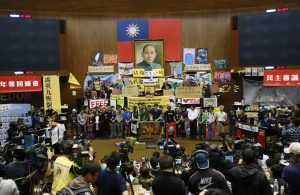In March 2014, the Kuomintang or KMT – then in control of both Taiwan’s presidency and the legislature – attempted to force through a controversial trade pact with China, the Cross-Strait Service Trade Agreement (CSSTA). The move drew outrage from civil society over concerns that the deal was opaque and would grant China too much influence over Taiwan’s economy.
On March 18, days before the KMT planned to put the bill to a final vote, student groups occupied the Legislative Yuan to show their anger over the CSSTA. It soon became clear that the students were not alone – public opinion wanted to put the brakes on then-President Ma Ying-jeou’s attempts to draw Taiwan closer to China. Hundreds of thousands turned out to show their support for the students in a rally on March 30. The occupation and related rallies now had a name: The Sunflower Movement.
It became a turning point in Taiwan’s politics. Not only was the CSSTA scrapped, but the KMT suffered major losses in the next election in 2016. It has not been able to win the presidency since, most recently losing in the 2024 polls. Meanwhile, the Sunflower Movement became a breeding ground for political talent for pan-Green parties.
Weiting Chen was one of the student leaders of the Sunflower Movement. In this interview, Chen, now a geopolitical analyst, discusses the factors that helped the Sunflower protesters succeed, and how the movement continues to reverberate in Taiwan’s politics today.
What were the major concerns that drove the occupation of the Legislative Yuan in 2014? Was it concern over China’s influence, Taiwan’s sovereignty, the “black box” nature of the bill, or all of the above?
All of the above. Before the occupation movement began in March 2014, civic groups and various industry-related organizations had already started protesting against the content of the Cross-Strait Service Trade Agreement (CSSTA) when it was signed in June 2013. These protests included sectors like telecommunications, publishing, advertising, media, and healthcare, all raising concerns that the trade deal could threaten Taiwan’s national security or impact Taiwanese workers adversely. Therefore, those fundamentally opposed to the trade agreement formed the core of the movement.
After the occupation movement started in March 2014, more people began to pay attention to this issue. These individuals were not necessarily opposed to the trade agreement in its entirety but quickly became aware of the government’s lack of transparency (the “black box” issue) in negotiating and reviewing the agreement. They believed the government had failed to conduct proper impact assessments, hence supporting the need for stronger supervisory mechanisms to scrutinize the CSSTA.
However, whether it was groups opposed to the CSSTA itself or those against the “black box” process, a common bottom line was the desire to prevent an increase in Chinese influence in Taiwan through the CSSTA, which could undermine Taiwan’s sovereignty.

































